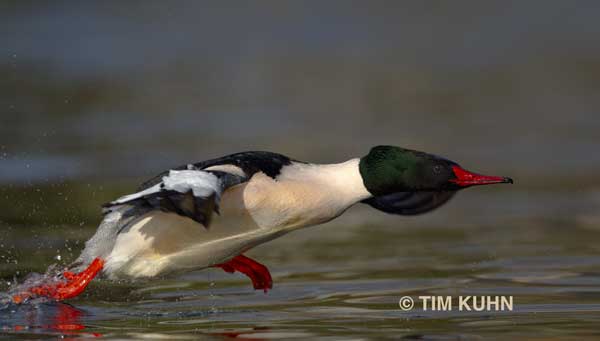I’ve always had a special fondness for submariners. Maybe it’s because I remember touring a submarine once with my mother. The sub was here as part of the Navy’s participation in Seafair, and my mom wanted to see all the ships.
The submarine we toured was resting on the surface of the Sound next to a pier, but the main part of the tour wasn’t above water. It was below. When my mother climbed down the ladder into the sub, the young crewmen started giving her wolf whistles because her skirt billowed out. Lord knows how much they saw, but it must have been an eyeful.
Instead of being embarrassed, my mother gave them another flirtatious flip of her skirt and some sexy banter. They roared with appreciation, and so did she. It was the first time I realized my mother was a person, not just a mom. I must have been about ten.
I guess that’s why I always smile whenever I see Common Mergansers fishing at the Fill. They remind me of submarines.
The male doing his business at Yesler Cove today was no exception. He had his head underwater like an upside down periscope, looking for prey. Common Mergansers are visual hunters. When they see a fish, they sound their inner “ba-wooga, ba-wooga,” and dive dive dive, just like all the submarines I used to watch on our little black-and-white TV in the 1950s.
This particular duck was patrolling the entrance to the cove, looking up from time to time to make sure he didn’t bump into traffic. A lot of Mallards and American Wigeons were clogging the mouth of the cove, too. It is a sign of the growing health of Yesler Cove, that both dabblers and divers find enough to eat here. And that thought makes me smile even more. Humans polluted this cove, but humans are also cleaning it up.
Eventually, the merganser decided to find a less populated place to fish, so revving up his feet like big propellers, he churned the water, flapped his wings, and was gone, leaving behind a big wake and a laughing birder.
FUN FACTS ABOUT COMMON MERGANSERS
• Common Mergansers are our state’s biggest duck. They measure a whopping 28 inches long.
• Males have dark green heads, alabaster white sides, and flaming red bills. Females have rust-colored heads with outrageous mullet-like crests.
• Mergansers’ bills have serrated, tooth-like projections along the sides that help them hold onto the slippery fish they catch.
• Mergansers nest in tree holes or sometimes in rock crevices along rivers in Western Washington and farther north. A day or two after the babies hatch, they tumble out of their holes and walk to the nearest water.
• Parents do not feed their babies, and the babies aren’t very good at catching fish at first. So they subsist on aquatic insects, mollusks, and crustaceans at first.
• Union Bay hosts Common Mergansers throughout the winter, but numbers increase dramatically in spring. We are a famous “staging area,” where multitudes of Common Mergansers gather for several days during migration, feeding in our rich waters and putting on fat for the enormous effort of breeding to come.

